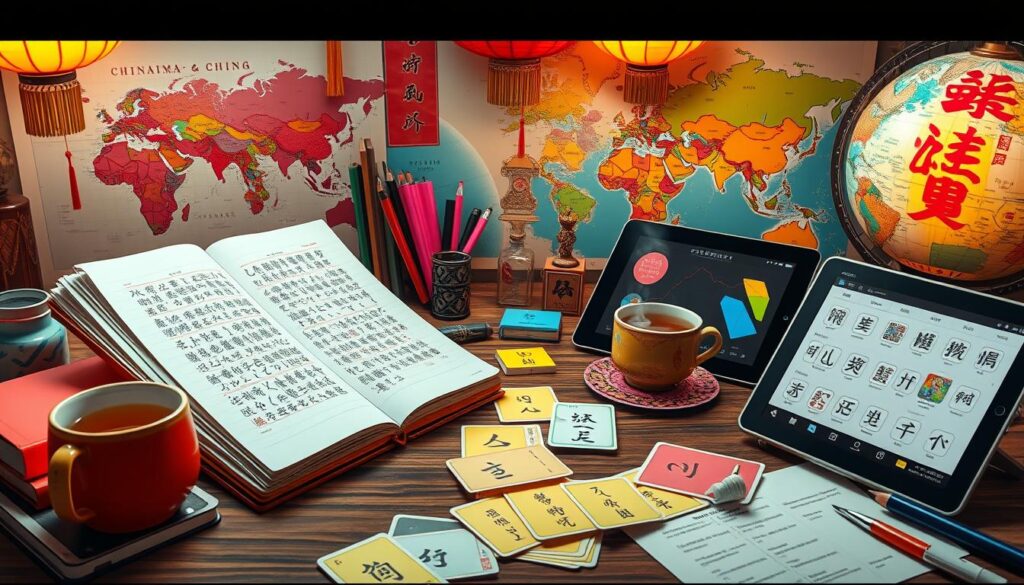Mastery of Chinese handwriting means diving deep into one of the world’s oldest languages. Over 50,000 Chinese characters exist, but you need to know at least 3,000 for daily use. Learning to write these characters by hand enhances your Mandarin learning experience far more than just reading and speaking. It allows you to appreciate the culture and the complex beauty of each character deeply. Enrich your Mandarin learning now.
Learning Chinese handwriting impacts how you learn the language on a cognitive level. Shaping symbols on paper is the start. But it teaches your brain to recognize and reproduce these characters accurately. The regular script, Kǎishū, is key to mastering clear writing that shows your commitment and skill. Such writing is valued both personally and professionally.
Getting the right tools is critical for learning Chinese characters. Online lessons offer a guided path to becoming fluent. They use smart methods like mind mapping and spaced repetition. Thanks to platforms like the Traverse app, learning becomes efficient and enjoyable. With tools like Skritter, your memory of characters strengthens, crucial for a language that requires constant practice.
Regular practice in handwriting is vital, whether on paper or digital devices. Resources from Arch Chinese and Mandarin Blueprint are invaluable. They provide stroke order animations and tailored worksheets to aid your practice. Mastering Chinese handwriting connects you to a tradition over 3,500 years old.
Discovering the Importance of Chinese Character Writing
The journey of mastering Chinese character writing is a deep dive into history and culture. It boosts our brain power too. As you explore the art of traditional Chinese writing, you’ll see it’s more than just writing. It’s a key to understanding a rich culture and sharpening your mind.
Fostering Deeper Cultural Connections Through Handwriting
Improving Chinese penmanship does more than make your writing look good. It connects us to a culture that’s rich in history. In our digital world, handwritten notes bring us closer to our heritage. It’s a heartfelt way to honor and preserve ancient traditions.
Making use of resources for learning Mandarin can also help with Cantonese. Many books teach both, making learning more effective. This approach enriches your cultural knowledge.
The Cognitive Benefits of Writing in Chinese Characters
Writing traditional Chinese characters is also great for your brain. Studies show it can improve memory and problem-solving abilities. Methods like Remembering the Traditional Hanzi make learning thousands of characters easier than just memorizing them.
Perceptions of Proficiency in Personal and Professional Arenas
Being good at Chinese character writing is seen as a big achievement. It shows deep language understanding. In professional settings, it can make you look more knowledgeable and respectful of Chinese culture. Tools like Skritter offer structured learning, keeping you on track with your studies.
| Tool/Resource | Description | Benefit |
|---|---|---|
| Remembering the Traditional Hanzi | Book series for character recognition | Speeds up the learning process |
| Skritter | App for learning to write Chinese characters | Interactive learning and feedback |
| LingQ | Language learning platform | Extensive reading materials in Mandarin and Cantonese |
Being dedicated to improving Chinese penmanship helps in many ways. It opens doors to new ways of communicating and understanding. Plus, it boosts your personal growth and career chances.
Learn Chinese Handwriting: The Gateway to Advanced Mandarin Proficiency
Learning mastering Chinese calligraphy is more than learning new writing. It’s stepping into the world of Mandarin. This language has complex characters and tones. Chinese characters tie into the fabric of Chinese culture and thought.
To get better at improve Chinese penmanship, knowing chinese stroke order practice matters a lot. Each stroke and order helps make characters look good and understandable. Writing Hanzi requires precision. Chinese stroke order practice helps remember characters. It makes sure they are drawn well and correctly.
Start with basic characters that shape more complex ones. Begin with common nouns, simple verbs, and key adjectives. Move to harder characters as you get better. Let’s talk about vital tools and resources for learners:
| Learning Stage | Focus Area | Recommended Resources |
|---|---|---|
| Beginner | Basic strokes, common nouns, and verbs | Yabla Chinese, FluentU |
| Intermediate | Proportions, compound characters | ChineseClass101, WuKong Chinese |
| Advanced | Personal weaknesses, feedback from native speakers | Anki, Remembering Simplified Hanzi |
Getting feedback from native speakers is key to mastering Chinese calligraphy. Writing Chinese is an art. It shows language skill. You need to work hard every day to improve.
To improve Chinese penmanship effectively, use tools like Mandarin Blueprint. It offers structured guidance. Understanding Chinese writing nuances becomes easier. Dive into the culture and philosophy behind each stroke. This improves your language skills and your love for this ancient art.
Strategies for Effective Chinese Calligraphy Practice
Exploring Chinese calligraphy practice is more than learning an art. It’s about connecting with traditional Chinese writing. To excel, knowing the basics and subtle details is key.
Mastering the Art of Brush Strokes and Stroke Order
Brush techniques and stroke order are crucial in Chinese calligraphy. Each stroke in traditional Chinese writing requires precision. They must follow a sequence, usually from top to bottom and left to right. This approach makes characters logical and beautiful.
Starting with good habits is vital. It lays the groundwork for mastering more complex skills.
Understanding Radicals: The Puzzle Pieces of Chinese Characters
Radicals are the building blocks of Chinese characters. They hint at the character’s meaning and sound. Knowing them makes learning easier since they appear in many characters.
Learning radicals is like getting keys to a vast kingdom of words. It’s crucial for advancing in Chinese calligraphy practice.
Incorporating Mindfulness in Character Writing for Better Retention
Writing Chinese characters involves both mind and body. Being mindful helps create a strong mental image of each character. This enhances memory and understanding.
The physical act of writing becomes more intuitive and precise. For more tips on mastering Chinese characters, see Hacking Chinese.
| Calligraphy Style | Historical Period | Characteristics |
|---|---|---|
| Seal Script | Before 221 B.C. | Emblematic and ceremonial |
| Clerical Script | Han Dynasty (206 BCE – 220 CE) | Bolder strokes and structured |
| Running Script | Common Use | Greater fluidity and speed |
| Standard Script | Common Use | Most universally recognized form |
Learning various styles enriches your Chinese calligraphy practice. It also broadens your appreciation for this art’s history.
Online Chinese Handwriting Lessons: Leverage Digital Tools for Improvement
Stepping into Chinese character writing? Using online Chinese handwriting lessons boosts your learning. Technology adds fun and effectiveness to your study routine.
Using tools like Traverse and Skritter helps you master Chinese handwriting. They teach stroke order and character structure. These platforms support learners at all levels, from beginners to advanced users.
The Traverse app improves your memory by practicing Chinese characters. Meanwhile, Skritter uses a spaced repetition system. It helps you remember over 90% of what you learn.
Skritter also has daily lessons and lets you enter words and phrases. It’s great for learning characters and real-life language use.
Online Chinese handwriting lessons are also affordable and easy to access. Prices vary from about $10 to $15 a month. Skritter even has a one-week free trial. So, no matter your budget, these platforms are available. And you can learn anytime, anywhere.
Learning the logic behind Chinese character writing is easier with digital lessons. Check out these structured lessons. They use a multimodal approach, including hearing, seeing, and writing. This helps build a strong foundation in Mandarin.
Regularly using these digital tools greatly improves your handwriting and language skills. Whether starting out or improving, online Chinese handwriting lessons guide you to mastering Chinese.
The Lifelong Journey of Mastering Chinese Calligraphy
Mastering Chinese calligraphy ties you to a 3,000-year-old tradition. It’s a heritage full of different scripts and styles. From the ancient seal script of the Qin dynasty to the 4th-century expressive cursive, every style offers a piece of history. This journey is more than learning shapes; it’s an exploration of cultural depth and beauty.
You’re entering a dialogue with history when you learn this art. The Song dynasty’s running script and the Tang dynasty’s standard script showcase evolving thoughts. As you learn, you understand each character’s history and meaning. This makes Chinese literacy not just about knowing characters but appreciating their beauty. Through resources like learning how to perfect characters, your study becomes rich and fulfilling.
Technology aids your quest to master Chinese calligraphy significantly. Traverse’s tools, for example, make learning characters easier. They connect sounds to visuals and help remember patterns. This tech aids you, whether you’re learning cursive or standard script. Remember, mastering calligraphy is a continuous journey. Your hard work enriches the tapestry of Chinese written heritage.


